How to Write a Rap Song: Listening
If you’re looking for someone to teach you how to rap or how to write a rap song, look no further – it cannot be taught. But that doesn’t mean you can’t learn.
Stop speaking in riddles, Nugget C! Okay. What I’m saying is, the best way to learn how to rap is to learn how to listen.
If you learn how to listen rappers, you will learn everything there is to know about rapping or writing a rap song.
Let’s dive in and I’ll suggest 12 tips on what to listen for and how to create your own rap verses and hooks.
TIP 1: Listen
The great rappers were able to create hip-hop because they were able to listen really well to hip-hop. Artists like Drake or Busdriver or Aesop Rock didn’t come up with their ideas without first listening closely to Biggie or Lauren Hill. Biggie and Lauren Hill didn’t create without first listening closely to Rakim or Public Enemy, and so on, going back to Melle Mel and single celled-organisms.
Without even looking into the past, the tradition of hip-hop today alone is HUGE. Most people I know, limit themselves to the American tradition, but it is way bigger than that. With all the Spanish rappers, Korean rappers, Caribbean rappers in London, Turkish rappers in Berlin, it’s easy to get overwhelmed.
And still, there’s room for your rhymes. As far as I know, this moment will not be repeated. And there’s probably only one of you. So your odds of making something unique are looking good.
Find something you love, something you think is worthy of repeating in this world, and listen closely. Put yourself in the shoes of your favorite rappers as if you were the person creating the track. Listening to how they put their tracks together, you will start to see the richness that went into even the most basically structured songs. In the tips below, I’ll suggest some things to listen out for.
TIP 2: Think about Cadence
Cadence in hip-hop is the accent of the rhythm of the text. Rap is traditionally in 4/4 time, meaning each bar is broken down into four beats. So, if you have four words that you want to fit into a bar, it would sound like:
Or if you had eight words or syllables to fit into 4 beats, it would sound like:
Each beat can be broken down into smaller parts, which allows you to fit more syllables into a bar. In this example, all the beats have just one syllable, except the 3rd beat, which has been broken down into three parts (also known as a triplet).
Stress
So, now if you want to stress the 2 and the 4 of the bar, traditionally the kick and snare beats, you put more emphasis on the black diamonds.
Observe how popular cadence has changed over the years in these three tracks:
Grandmaster Melle Mel, uses a cadence mostly on two and four.
Rakim was influential in changing the way cadence was used. His cadence falls often on two and four here, but he changes it up a lot.
And here, later in the development of hip-hop, we find Mos Def changing the cadence all the time.
Tip 3: Play with a Rhythmic motive
Some rappers use a rhythmic motive in their cadence instead of the natural rhythm of the words. For example, Kendrick Lamar often uses a totally unnatural rhythm to his words. In B***h don’t kill my Vibe, Lamar uses this motive as the basis for his cadence :
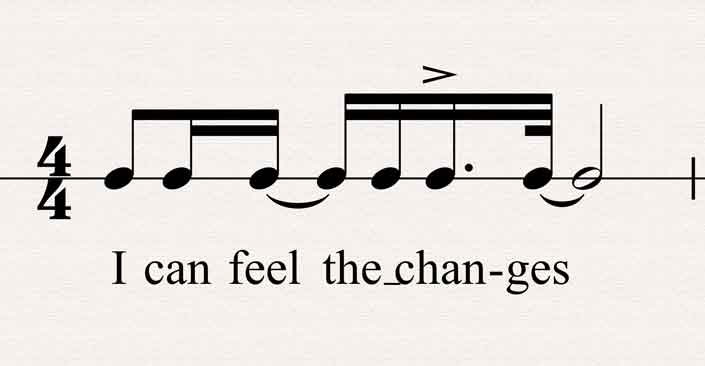
Rhyme
Rap uses rhyme in all its complexity. It takes rhyme to levels you won’t find in other musical genres. It is also the key to the idea of flow.
Flow:
the relationship between the rhythms, the accents (or cadence), and the rhymes of the rapper.
Rhyme is so cool because it can write your rap lyrics for you. Whether you freestyle or use a rhyming dictionary, it takes a life of its own. It’s sort of like you’re not there.
Tip 4: Use end rhymes and internal rhymes
Listen to how rappers use end rhymes. End rhymes happen at the end of the bar.
I’m like Sam the butcher bringing Alice the meat |
Like Fred Flintstone driving around with bald feet |
Beastie Boys, Shake Your Rump
Internal rhymes happen within the bar. Here’s an example:
And if you choose to eat, you could lose your teeth |
Many crews retreat, nightly news repeat |
Mos Def, Respiration
Tip 5: Use syncopated rhymes and rhymes that carry over the bar line
Listen for rhymes that cross over the bar line, or don’t hit the big beats. Listen to Deca’s Gabriel Ratchet here below. Notice how some of the rhymes happen on off beats and how his thoughts carry over the ends of the bar:
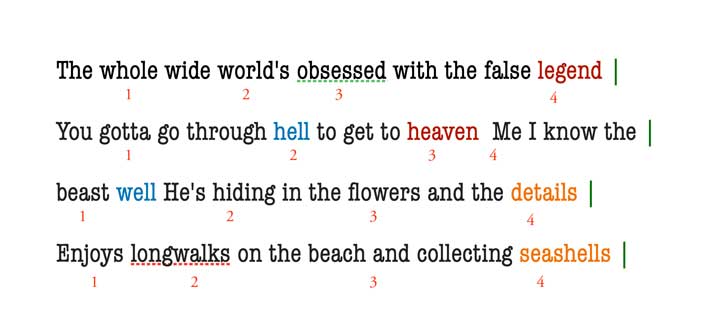
Tip 6: Use Rhyme to create tension
Listen to how Biggie uses rhyme to create tension. By changing up the rhyme scheme and flow, the listener can’t predict what’s coming next. It’s uneasy and exciting at the same time, which is what he’s going for.
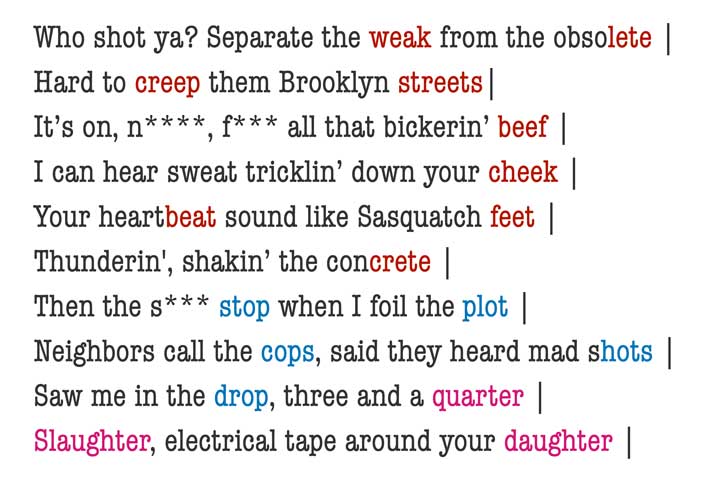
Tip 7: Take Rhyme to the Extreme
Experiment with how far you can go with rhyme. Check out how far MF Doom takes it here. There are very few words that don’t rhyme.
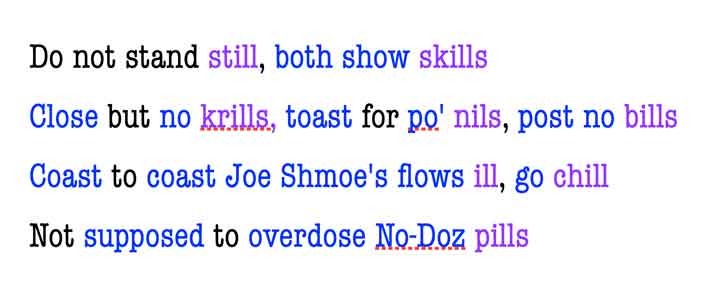
Tip 8: Listen For Form
You can learn a lot just by listening closely and noticing how rappers structure their tracks.
A traditional structure might be:
ABAB – Verse-chorus-Verse-chorus
or
ABABCB – Verse-chorus-Verse-Chorus-Bridge-Chorus
As with, Cadence and Rhyme, you don’t have to re-invent the wheel with any of these elements. If you’re all bent on being clever and individual, you can try to create your own new form, but my guess is after a lot of headaches, you’ll probably come back to a standard ABAB, Verse-Chorus-Verse-Chorus form, and think, “Wow! That works.”
One of the reasons the standard forms work so well is that listeners know what they’re getting into. Whether they are aware of it or not, your listener is used to ABAB form. If you vary from this too much then the listener needs to waste a lot of time and energy trying to figure out where they are and what you’re up to rather than just taking in what it is you’re trying to express.
Let’s check out what some great rappers do.
Here below, this is a classic standard Rap form. We know what we’re getting and it works beautifully.
Outkast, The Way You Move
Intro – 8 bars
Verse 1 – 16 bars
Chorus – 16 bars
Verse 2 – 16 bars
Chorus – 16 bars
Bridge – 16 bars
Chorus – 16 bars
Here below, we have an example of how you might modify a standard form. Notice how the second verse is surprisingly 2 bars short.
The Notorious B.I.G., Ready to Die
Verse 1 – 16 bars
Chorus – 4 bars
Verse 2 – 14 bars
Chorus 4 bars
Verse 3 – 16 bars
Chorus x 2
Finally, this Mos Def track is an example of a more complex form. It’s surprising to me how elegant it is and how well he pulls it off. I don’t even think about its complexity when listening.
Mos Def, Love
Intro
Chorus 1 (“I start to think”) 4 bars x 2
Verse 32 bars
Chorus (“I start to think”) 4 bars
Post-Chorus(“I got love”) 8 bars
Bridge 8 bars (“check it out y’all”)
Verse 28 bars
Chorus (“I start to think”)
Post-Chorus (“I got love”) 8 bars
Ideas for Your Own Creation
TIP 9: Open a book or look at a picture
A lot of times if you try to express your thoughts and rhyme them, they come out forced, or they sound like something you’ve heard a thousand times. Sometimes you have to trick your mind into giving you the gold nuggets. Try this:
Open a book and take the first words on a page that mean something to you. Find rhymes for these words.
Look at a photograph. Write down words that come to mind when you look at it. Rhyme these words. You’ll get more ideas as the page fills.
(See here for more ideas on lyrics and and how to write songs)
TIP 10: Create your own beat or instrumental
The energy of the song you create should be driven by the beat. You can choose some ready-made beats (there are tons of free options online for beats and instrumentals), but if you want to make something real, make your own.
Making your own beats is not that hard and it will inspire more ideas for your lyrics. Here are a few ideas for ways to make your own:
- play with a real drummer. This is the best option if you know a drummer or are one. Rap with live drummers is WAY better!
- Use a DAW. Logic Pro, Ableton Live, Pro Tools, Cubebase – all of these DAWs have drum machines, loops, and drummer tracks to help you find beats that work for you. Logic Pro’s drummer is easy and versatile. Garageband is the simplified version of Apple’s Logic Pro. You can create great stuff, and it’s free if you have a mac.
- Use an actual drum machine like the Roland TR-08. These things are endless inspiration for writing a rap song.
TIP 11: Use the Rakim method
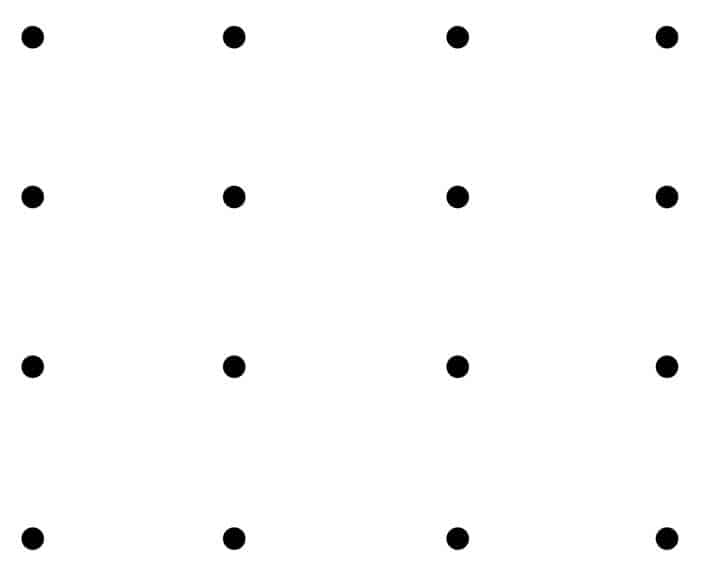
Rakim’s method for writing rap lyrics is to put 16 dots on a page representing four bars. This gives you an outline of the beats in those for bars and a starting outline for where the syllables might fall. Put your lyrics under the dots and you start to get ideas.
“
Since fat Crayons, I write and display chaos
Rakim – Guess Who’s Back?
TIP 12: Don’t forget about Melody
Rappers like Drake have brought melody back into the limelight in hip-hop. For your Chorus you’re often going to want a hook, which is really just a melody. For some great ideas on creating melodies all things songwriting follow this link)
Questions or Comments?
Join the discussion here on Facebook.
[questlove_shortcode]